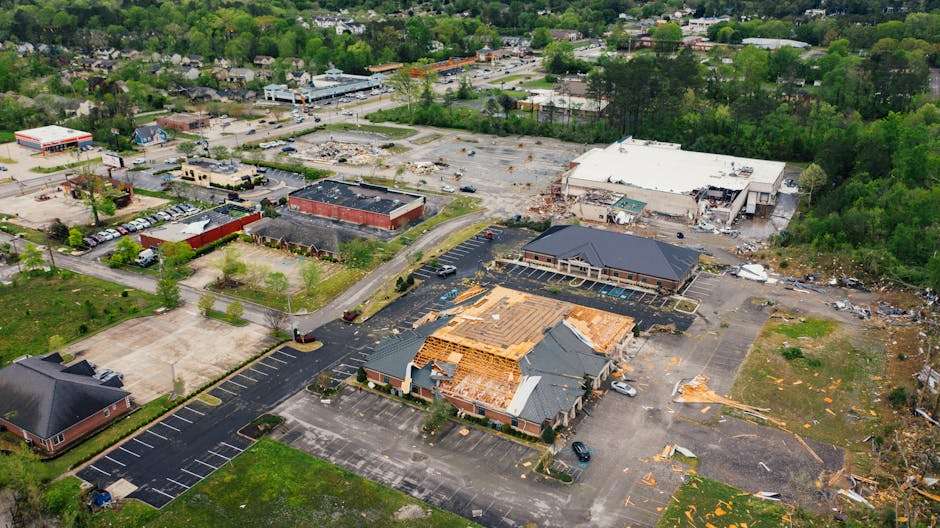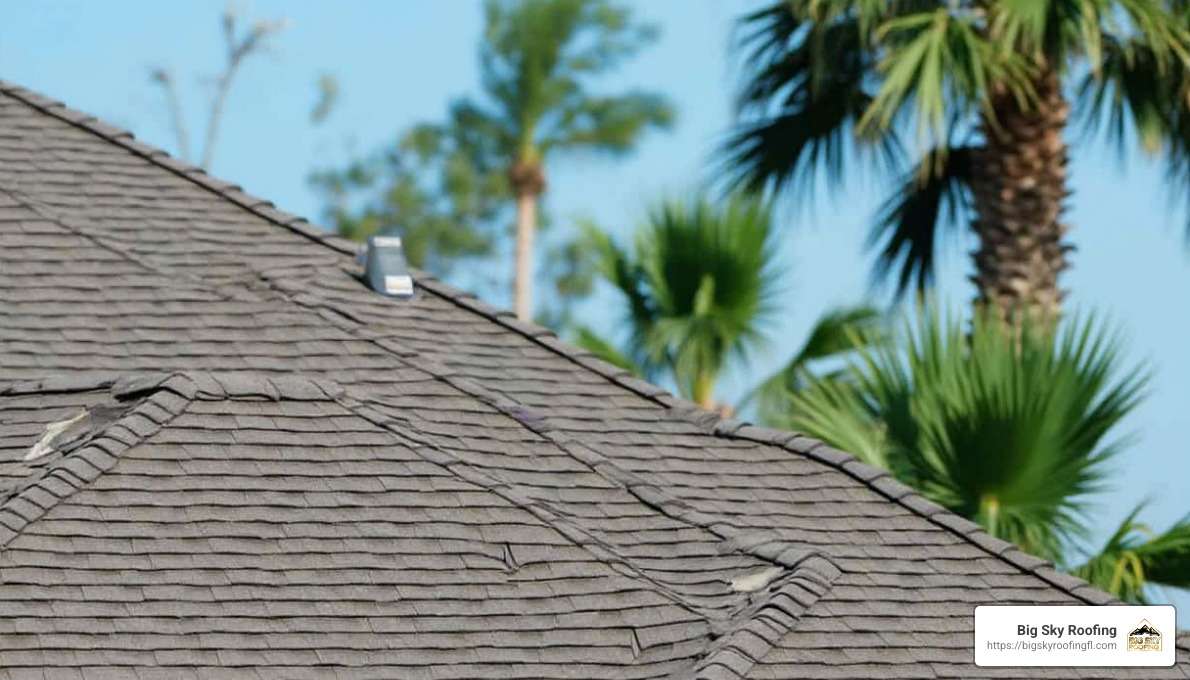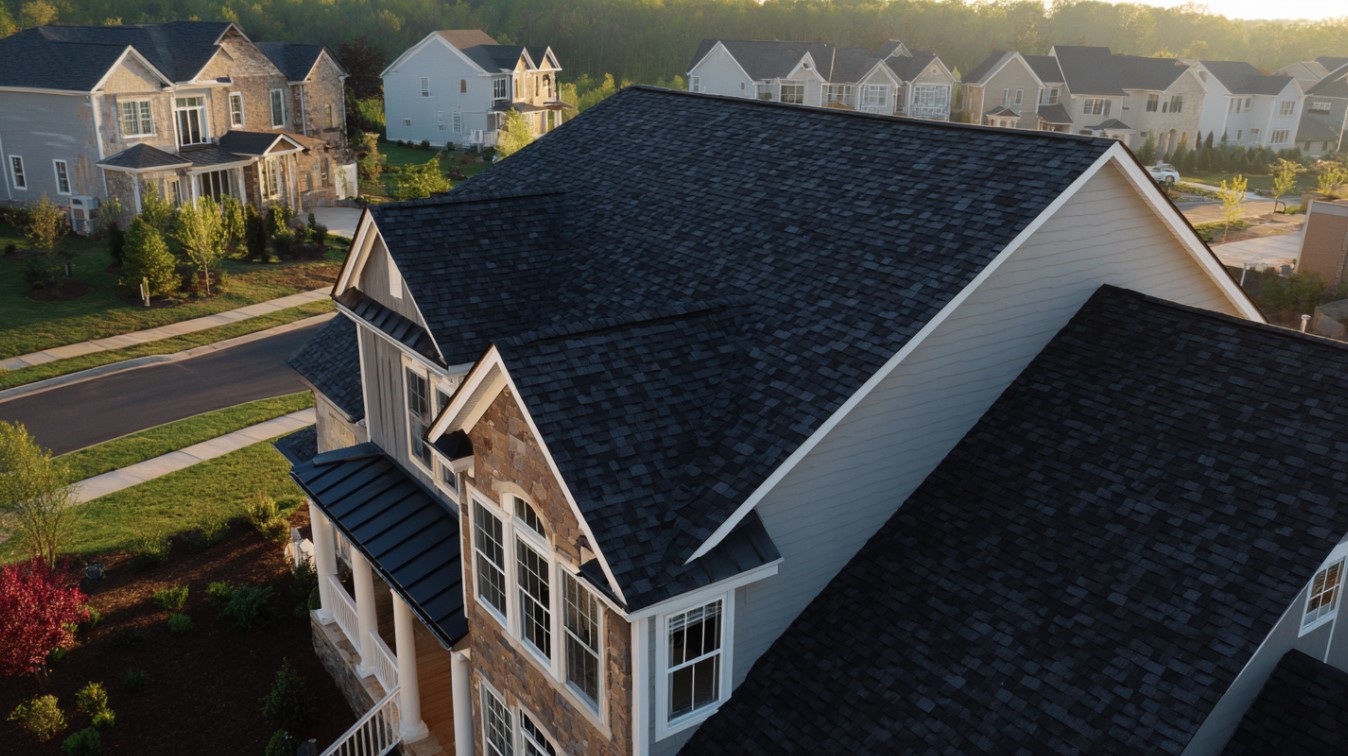Commercial Roofing Repair Essentials Every Florida Business Owner Should Know
•
Written By
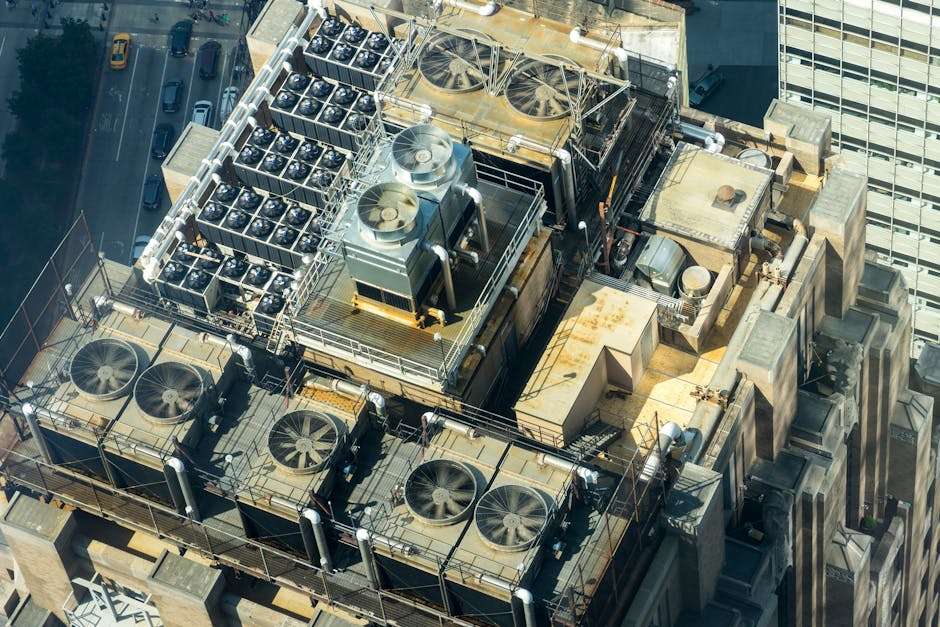
Protecting Your Business Investment: Why Commercial Roofing Repair Matters
Roofing repair for commercial buildings is essential for Florida business owners who want to protect their investments and ensure business continuity. Here’s what you need to know:
- Average Cost: $1,067, with most repairs ranging from $379-$1,755
- When to Repair: Missing shingles, water stains, sagging areas, damaged flashing
- When to Replace: If more than 30% of your roof is substantially damaged
- Emergency Signs: Water entering your building, structural compromise, leaks near electrical systems
Florida’s unique climate presents significant challenges for commercial roofs across Sumter, Lake, Citrus, Hernando, Orange, and Marion counties. With intense sun, heavy rainfall, hurricane-force winds, and occasional hail, your commercial roof faces more wear and tear than in most other states.
Every day you delay necessary roofing repair adds to the potential cost.
A minor leak that might cost $500 to fix today could lead to structural damage, inventory loss, and business interruption costing tens of thousands tomorrow. According to our research, approximately 60% of roof repair costs go toward labor, making early intervention even more financially prudent.
Smart business owners understand that preventive maintenance and timely repairs are not expenses—they’re investments that protect far more valuable assets: your building, equipment, inventory, and most importantly, your business operations.
“When the unthinkable happens, having a relationship with a trusted roofing professional makes all the difference,” notes one Florida business owner who avoided a week-long shutdown after a storm by having emergency repair protocols in place.
Whether you’re dealing with a flat TPO system, metal roofing, or traditional shingles, understanding the essentials of commercial roofing repair will help you make informed decisions that protect your bottom line.


Roofing repair terms made easy:
– roof repair Florida
– roof replacement near me
Commercial Roof Damage Warning Signs
Florida’s harsh climate can be brutal on commercial roofs. From scorching sun to hurricane-force winds, businesses across Sumter, Lake, Citrus, Hernando, Orange, and Marion counties face unique challenges that can quickly turn small roofing issues into costly disasters.
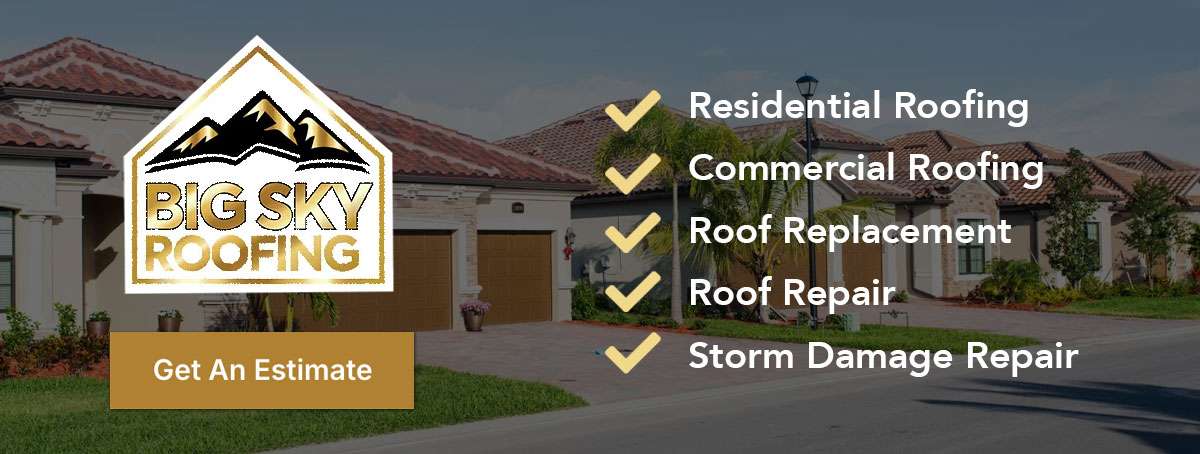
After helping business owners for over 25 years, we’ve learned that catching problems early can save thousands. Here are the telltale signs your commercial roof needs attention:
Standing water that remains more than two days after rainfall isn’t just normal – it’s a red flag that can lead to premature aging and leaks. Similarly, blistering (those bubbles you might spot on your membrane roof) signals trapped moisture or heat damage that weakens your roofing system from within.
Keep an eye out for membrane punctures too. Even small tears create direct entry points for water, while flashing gaps around roof penetrations practically invite leaks inside. When you notice moisture stains on your interior ceilings, water has already found its way in – time is of the essence.
Don’t overlook drainage issues. Those clogged gutters, scuppers and downspouts might seem minor, but they’re actually preventing thousands of gallons of water from properly exiting your roof. And after strong winds, check for signs of wind uplift – loose or billowing sections of membrane that can tear away entirely in the next storm.
“Last year, we inspected a warehouse in Marion County where the owner had ignored some small membrane tears,” shares our lead technician. “By the time they called us, water had damaged $30,000 in inventory. What would have been a simple roofing repair became a major restoration project and insurance claim.”
Visual Inspections Facility Managers Can Do Daily
Your maintenance team can be your first line of defense against roof damage. We recommend a quick daily walk-around (from ground level) and a more thorough monthly check that includes:
Clearing roof debris that can block drainage and hold moisture against your roofing materials. After storms and during fall, pay special attention to clogged scuppers that can cause water to back up and find weak points.
Look for loose fasteners – those popped screws or nails are often the first sign that your roof is shifting or that wind damage has occurred. Never walk on a potentially compromised roof surface; these inspections should be done safely from ladder height or through roof access points.


Hidden Red Flags Uncovered During Professional Roofing Repair Inspections
While visual checks are valuable, some of the most serious roof problems remain invisible until a professional assessment. At Big Sky Roofing, we use specialized techniques to find issues before they become catastrophes:
We employ thermal imaging to detect moisture trapped beneath the surface that would otherwise go unnoticed until damage is extensive. Our team also performs core cuts – small sample extractions that reveal the true condition of underlying insulation layers.
Saturated insulation is particularly troubling, as it not only promotes corrosion and mold growth, but also dramatically reduces your building’s energy efficiency. Our detailed ponding analysis identifies structural deflection that might be invisible to the naked eye but creates water collection points.
We’ve found that nearly 40% of the commercial roofs we inspect across Citrus and Hernando counties have hidden moisture issues their owners knew nothing about. These problems won’t appear during casual inspections but will eventually lead to significant damage and costly repairs.
For a comprehensive approach to assessing your roof’s condition, download our Roof Inspection Checklist Florida to ensure nothing gets overlooked during your next inspection.
When it comes to commercial roofing, what you can’t see can hurt you – and your bottom line. Regular professional inspections are an investment that pays dividends in avoided emergency repairs and extended roof life.
Commercial Roofing Repair Costs in 2025
Planning your budget for roofing repair needs shouldn’t feel like solving a mystery. As we steer through 2025, Florida business owners across our service areas are facing some unique cost considerations that are worth understanding.
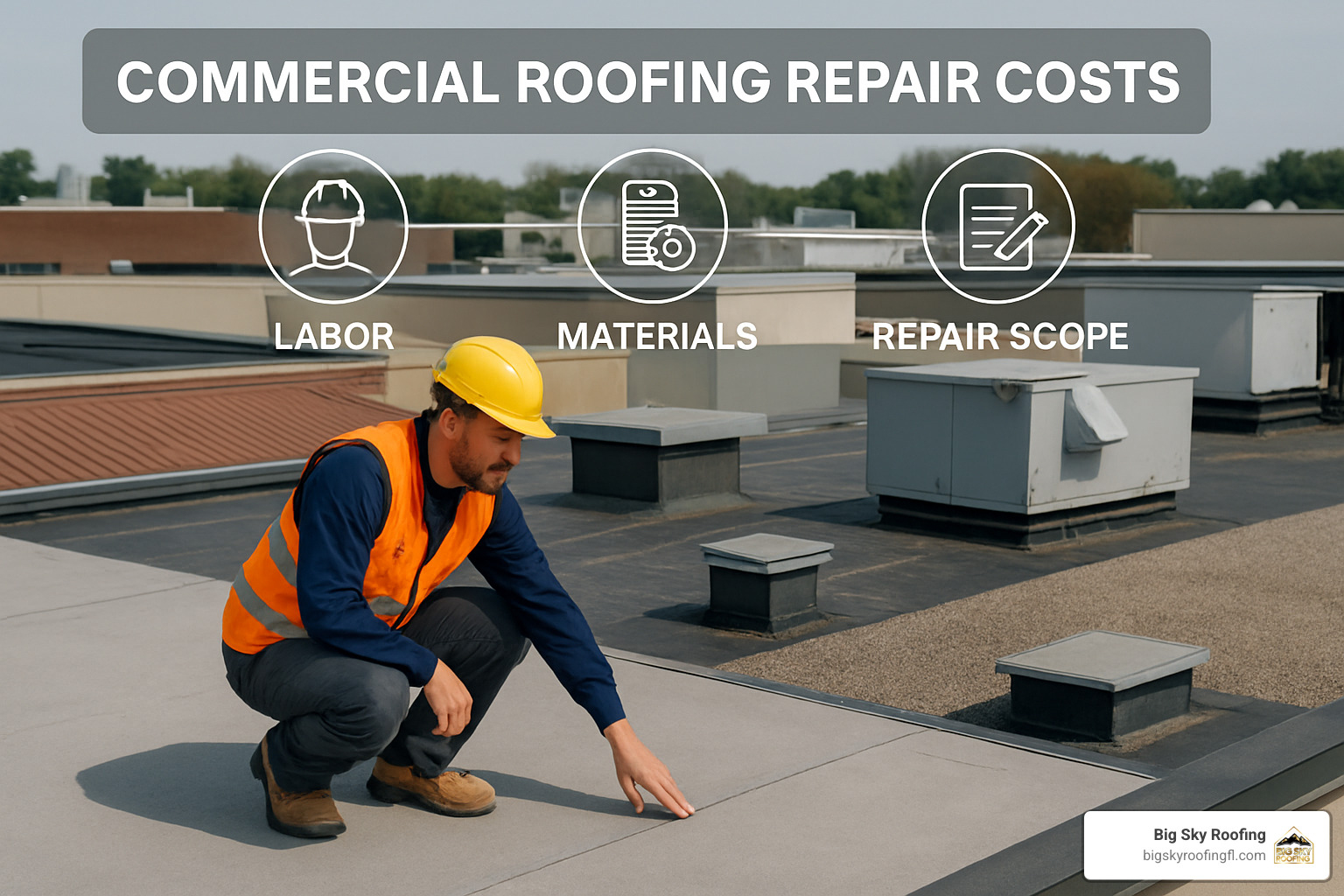

Right now, the average commercial roof repair in Central Florida sits at around $1,067. But like most things in life, there’s a range—from about $379 for those smaller fixes (think isolated leaks or minor wind damage) up to $1,755 for more substantial work. When we’re talking major structural repairs, particularly after severe storms, costs can easily climb beyond $3,000.
What’s driving these costs in today’s market? About 60% goes toward labor—skilled roofers who understand Florida’s unique building codes don’t come cheap! Material pricing continues to fluctuate, though we’re seeing some stabilization compared to the wild swings of recent years. Supply-chain trends have improved since the challenges of 2023-2024, but certain specialized materials still face availability issues.
“Gone are the days when we could quote prices off the top of our heads,” our project manager often tells clients. “Today’s material market changes so frequently that we need to provide fresh, property-specific quotes to ensure you’re getting accurate figures.”
We’ve noticed businesses in Sumter, Lake, and Orange counties typically see slightly higher labor rates due to demand patterns, while our clients in Citrus, Hernando, and Marion counties benefit from more competitive pricing in some categories.
For a personalized estimate based on your specific situation, our Roofing Cost Estimator tool can help you get started with some preliminary numbers.
How Roof Pitch & Design Alter Your Roofing Repair Budget
Your roof’s physical characteristics play a huge role in determining repair costs—something many business owners don’t initially consider.
Low-slope configurations (what most people call “flat roofs”) are generally easier for our teams to work on, but they require specialized membrane systems that can cost more per square foot. Parapets and edges add complexity, requiring additional flashing and detail work that increases labor hours. Rooftop HVAC units and other equipment mean our crews need to carefully maneuver around obstacles, adding time to the project.
Safety is always our priority, which means steeper pitches require additional fall protection systems that add to overall costs. Complex layouts also extend what we call staging time—the hours spent just setting up to do the actual repair work.
One of our Marion County clients recently learned this lesson firsthand. “I assumed my small retail space would cost less to repair than my neighbor’s larger warehouse,” he told us. “But my building’s multiple roof levels and decorative facade elements actually made the job more labor-intensive despite having half the square footage.”
According to our project data, roof slopes exceeding 8:12 pitch can add $1,000-$3,000 in labor costs alone due to the additional safety requirements and slower work pace required.
Roofing Repair Cost Breakdown by Material & Feature
Different roofing materials come with different price tags when it comes to repairs. Here’s what you can expect across our Central Florida service area:
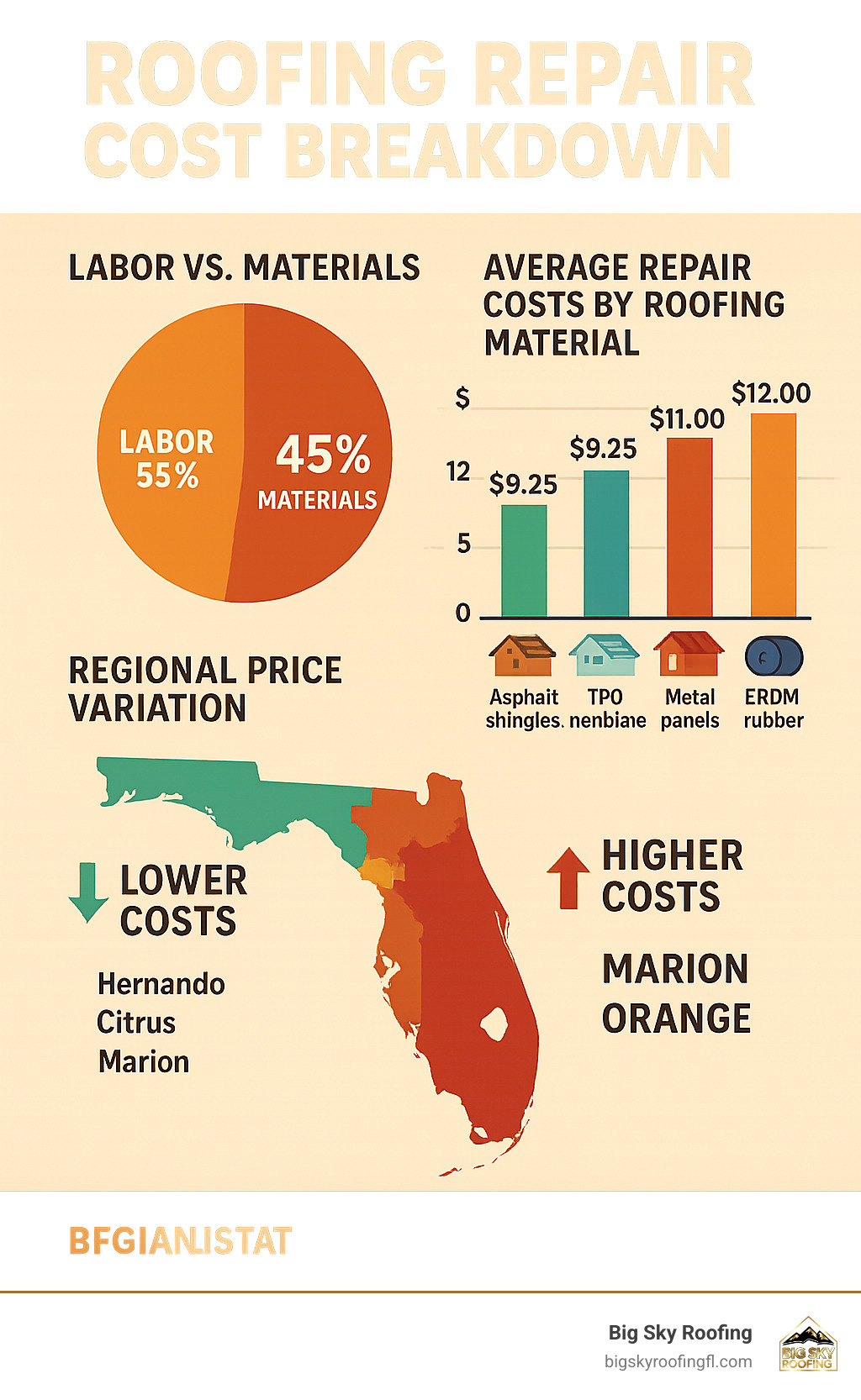

When it comes to materials, TPO membrane repairs typically run $7.50-$12.00 per square foot—a popular choice for many Central Florida businesses due to its heat-reflective properties. Metal panels, which stand up well to our intense sunshine, generally cost $8.50-$15.50 per square foot to repair. PVC membrane systems, known for their durability against ponding water, average $8.00-$14.00 per square foot for repairs.
For businesses with traditional asphalt shingle sections (often on visible, sloped portions), repairs run $4.25-$8.25 per square foot. Modified bitumen repairs typically fall in the $6.00-$10.00 range, while EPDM rubber systems average $5.50-$9.50 per square foot.
Beyond the main roofing material, specific features have their own repair costs. Skylight flashing repairs typically cost $300-$600, depending on size and accessibility. Drip edge replacement runs about $180-$350 per linear section. Repairing roof penetrations like pipe boots costs around $150-$300 each—a small price to pay considering these are common leak points.
“The smartest approach is bundling multiple repairs into one project,” our senior estimator always advises. “We recently helped a Lake County business owner save nearly 30% by addressing three separate issues during a single visit, cutting down on those mobilization costs that add up quickly.”
Our clients in Hernando and Citrus counties often see slightly lower repair costs compared to those in Orange and Lake counties—a reflection of regional differences in labor markets and permitting fees that we pass along whenever possible.
Planning for these costs now means fewer surprises later. And remember—addressing small roofing repair needs promptly almost always prevents more expensive emergencies down the road.
Repair, Re-Cover, or Replace? Making the Right Call
When your commercial roof shows signs of damage, you’re faced with a pivotal decision that impacts both your immediate budget and long-term business operations. Should you repair the existing roof, install a new membrane over the old one, or tear everything off and start fresh?
At Big Sky Roofing, we help Florida business owners steer this decision using clear, objective criteria rather than guesswork.
“Last year, a Marion County warehouse owner called us about visible damage to about 20% of their TPO membrane,” shares our commercial division manager. “They assumed a simple roofing repair would suffice. However, our moisture scan revealed that 40% of the insulation underneath was completely saturated. This hidden damage made replacement the more economical choice in the long run.”
We evaluate several key factors to guide your decision:
The 30% damage rule serves as our starting point—industry standards suggest replacement when more than 30% of your roof is compromised. We also consider your remaining warranty coverage, the structural integrity of your roof deck, and your current insulation’s R-value compared to modern energy codes.
Environmental factors matter too. We calculate landfill fees for disposal and consider your business’s sustainability goals when making recommendations.
For a deeper dive into evaluation criteria, visit our Roof Repair Services page.
Benefits of Timely Roofing Repair Over Full Tear-Off
When damage is limited in scope, prompt roofing repair offers substantial advantages for your business.
First, there’s the obvious capital preservation—repairs typically cost just 15-25% of what you’d spend on full replacement. From a tax perspective, repairs are often fully deductible in the current tax year, unlike replacements which may require depreciation.
Your operations benefit too. Repairs mean minimal downtime and improved occupant safety with reduced exposure to the elements during work. Quality repairs can add 5-10 years to your roof’s lifespan while preserving existing manufacturer guarantees.
A retail center we worked with in Lake County exemplifies this approach perfectly. By implementing a proactive repair program for their aging modified bitumen roof, they’ve extended its life by seven years beyond the expected replacement date.
“They’ve saved over $120,000 in capital expenditures so far,” explains our preventative maintenance coordinator. “We track these numbers carefully, and our commercial clients typically see a 400-600% return on their repair investments when measured against deferred replacement costs.”
When Re-Cover Outperforms Traditional Roofing Repair
Sometimes, the sweet spot isn’t repair or replacement—it’s re-covering, which means installing a second membrane over your existing roof.
“For a Sumter County office complex with an aging but dry EPDM roof, we installed a TPO recover system,” our commercial project manager explains. “This approach saved them 35% compared to replacement costs while providing a new 20-year warranty and improving their energy efficiency by 22%.”
Re-covering offers several distinct advantages: you get a new warranty without the full tear-off costs, experience minimal disruption to your operations, and contribute to environmental sustainability by reducing landfill waste. It’s typically 30-40% less expensive than full replacement.
Before recommending this approach, we conduct a thorough moisture scan to verify your existing insulation is dry. We also evaluate your building’s structural capacity to handle the additional weight and check current code compliance for multiple roof layers.
It’s worth noting that re-cover isn’t always an option. Florida building codes limit the number of roof layers, and moisture-compromised systems generally require complete removal. Our assessment process helps determine if this approach makes sense for your specific situation in Citrus, Hernando, Orange, or other Central Florida counties we serve.
Emergency Roofing Response & Insurance Claims in Florida
When Florida storms strike, your business is suddenly at the mercy of nature’s fury. Hurricane winds, unexpected hail, tornadoes, and severe thunderstorms don’t wait for business hours – and neither do we. Having a solid emergency response plan isn’t just good business sense; it’s essential for survival in our unpredictable climate.


At Big Sky Roofing, we’ve been there for hundreds of panicked middle-of-the-night calls from business owners across Sumter, Lake, Citrus, Hernando, Orange, and Marion counties. Our 24/7 emergency response isn’t just a service – it’s a lifeline when you need it most.
“It was like watching a miracle unfold,” remembers a restaurant owner in Hernando County. “After that severe thunderstorm tore through at 2 AM, Big Sky had a team on-site by sunrise with tarps and equipment. While my competitors stayed closed for days, we were serving dinner the next evening.”
Our emergency response includes rapid on-site assessment within hours, not days; immediate emergency tarping to prevent further damage; thorough photo documentation for your insurance claim; professional water extraction to prevent mold and secondary damage; temporary repairs that keep your doors open; and experienced insurance liaisons who speak adjuster language fluently.
For more details on how we handle emergencies, visit our Emergency Roofing Services in Central Florida page.
5 Steps to Stabilize Your Roof Before the Pros Arrive
Those first moments after finding roofing repair emergencies are critical. Here’s what smart business owners do while waiting for our team to arrive:
Stay off the roof – what looks stable might not be. We’ve seen too many well-intentioned owners create bigger problems and risk personal injury.
Shut off power if water is entering electrical areas. A Marion County retail manager once told us, “That single tip saved my inventory and probably prevented a fire.”
Protect what matters by covering equipment, inventory, and furnishings with plastic sheeting. Keep some in your emergency kit – it’s worth its weight in gold during a crisis.
Contain active leaks with buckets and containers to prevent water from spreading. This simple step saved a Lake County medical office thousands in equipment damage during last year’s severe storms.
Document everything and call your insurer immediately. Use your smartphone to capture video and photos before moving anything – this documentation is priceless for your claim.
“The difference between businesses that survive emergencies and those that don’t often comes down to those first few hours,” notes our emergency team leader. “A little preparation and knowing these steps can literally save your business.”
Filing a Claim Without Headaches
The storm might be over, but now you’re facing the paperwork storm. After helping hundreds of Central Florida businesses steer insurance claims, we’ve learned what works and what doesn’t.
Know your policy before disaster strikes. Many Florida commercial policies now include special provisions for wind and hail damage with percentage-based deductibles rather than fixed amounts. This can mean a significantly higher out-of-pocket cost than you might expect.
Get your claim number immediately and keep it handy – you’ll need it for every conversation about your claim.
Insist on detailed documentation from your roofing professional. Generic descriptions won’t cut it with adjusters. Our teams provide comprehensive damage assessments that speak the language of insurance.
Be prepared for supplements as repairs progress. Often, removing a damaged section reveals additional problems that weren’t visible during the initial inspection.
Partner with experienced professionals for adjuster meetings. Having your roofer present can make all the difference, as one Orange County property manager finded: “Big Sky’s project manager explained the technical aspects to my adjuster in a way I never could. That conversation turned my denied claim into a fully covered $42,000 repair.”
For businesses with multiple properties across Citrus and Sumter counties, we recommend developing a standardized claim protocol that can be quickly implemented during regional weather events. This consistency helps ensure nothing falls through the cracks when you’re managing multiple emergency situations simultaneously.
Timely roofing repair after storm damage isn’t just about fixing what’s broken – it’s about protecting everything beneath that roof: your equipment, inventory, employees, and ultimately, your business’s future.
Hiring the Right Commercial Roofer in Central Florida
Finding the perfect partner for your commercial roofing repair needs might be the most important decision you’ll make in this whole process. After serving Central Florida businesses for over 25 years, we’ve seen how this choice directly impacts not just the immediate results, but also long-term roof performance and your bottom line.
When you’re evaluating potential roofing contractors, there are several non-negotiable qualifications to look for. License and insurance verification should be your starting point – always confirm they hold a current Florida roofing contractor license and carry substantial liability coverage. Their safety record speaks volumes about their professionalism, so don’t hesitate to ask about OSHA compliance and established safety protocols.
“After Hurricane Irma hit, we saw so many out-of-state contractors swooping in with promises of quick fixes at bargain prices,” our operations manager often recalls. “Many business owners in Citrus County learned a painful lesson when these companies disappeared after collecting payments, leaving behind subpar repairs and no way to reach them.”
Always request local references from commercial clients in your specific county, whether that’s Sumter, Lake, Citrus, Hernando, Orange, or Marion. A contractor who can provide NDL warranties (No Dollar Limit) from manufacturers shows they’ve met rigorous certification standards. And don’t overlook the importance of realistic project timelines with dedicated commercial crews and clear communication protocols so you always know who to call with questions.
For businesses dealing with active leaks right now, our Roof Leak Repair services provide fast solutions that address the underlying causes – not just temporary patches over symptoms.


Screening Questions Every Business Should Ask a Roofing Repair Contractor
Before signing any contract, have a candid conversation with potential roofing partners. These questions will help you separate the professionals from the pretenders:
“Will you use your own employees or subcontractors?” The answer reveals a lot about quality control and accountability.
“How will you protect my property and operations during repairs?” Their daily cleanup procedures should minimize disruption to your business.
“What specific products will be used and why?” Reputable contractors can explain their material choices and why they’re right for your building.
A Lake County medical facility recently shared how these questions saved them from a potential disaster. “Our lowest bidder planned to use temporary workers with no experience in occupied healthcare settings,” our commercial division leader explained. “The slight premium they paid for experienced professionals prevented potential HIPAA violations and patient disruptions.”
Also ask about their change-order policy for handling unforeseen conditions, who will be your main project management contact, how they’ll minimize business disruption, their payment schedule, and what post-repair support they offer if issues arise later.
At Big Sky Roofing, we provide detailed written responses to all these questions before any contract is signed. We believe in complete transparency from the very beginning.
Why BBB Accreditation & Local Presence Matter
Two factors consistently predict positive outcomes when selecting a commercial roofing contractor in Central Florida: BBB accreditation and established local presence.
A strong trust rating through BBB accreditation demonstrates a commitment to ethical business practices and proper complaint resolution processes. A contractor’s service radius matters too – local professionals understand regional building codes and weather patterns that national chains might miss.
“We chose Big Sky Roofing for our Sumter County warehouse repair because they had a proven track record right here in our community,” a local business owner recently told us. “When we needed follow-up work a year later, they were still here—unlike the national chain our competitor used that had since closed their local office.”
Community investment signals long-term accountability – contractors with deep local roots can’t afford to damage their reputation. Their physical response capability also means faster emergency service when storms hit. Our decades-long presence across Central Florida means we understand the unique challenges each area presents – from the coastal influences affecting Citrus County to the different building code interpretations in Orange County.
For more perspectives on choosing qualified contractors, consider Share on LinkedIn with your professional network to get feedback from colleagues.
Frequently Asked Questions About Commercial Roofing Repair in Florida
How long does a typical commercial roofing repair take?
When Florida business owners ask us about repair timelines, we understand they’re really asking: “How long will this disrupt my business?” The honest answer depends on your specific situation.
For minor repairs like patching small leaks or fixing a few damaged areas, we typically complete the work in just 1-2 business days. Moderate repairs involving multiple sections or detailed flashing work generally take 3-5 business days. When facing major repairs that address structural issues or large damaged sections, plan for 1-2 weeks from start to finish.
Of course, this is Florida we’re talking about! Our unique weather patterns can throw curveballs into even the most carefully planned timelines. During our rainy season from June through September, those afternoon thunderstorms might force us to tarp up and resume work the following morning. And as all Floridians know, hurricane season preparations can affect scheduling between June and November.
“When repairing a 15,000 sq. ft. commercial roof in Marion County last year, we originally estimated a 4-day project,” explains our project coordinator. “However, unexpected deterioration beneath the membrane extended the timeline to 6 days. We communicated this immediately and worked extended hours to minimize the impact on the client’s operations.”
For emergency situations, we pride ourselves on same-day response teams that stabilize the immediate threat, followed by permanent roofing repair solutions as weather and materials allow.
Can roofing repair work be done without shutting down operations?
Yes! One of the most common concerns we hear from business owners across Sumter, Lake, and Orange counties is whether they’ll need to close their doors during repairs. The good news is that in most cases, we can complete commercial roofing repair while you maintain normal business operations.
Over our 25 years serving Central Florida, we’ve developed specific techniques to minimize disruption:
“For a Hernando County retail client, we performed extensive repairs during overnight hours to avoid customer disruption,” shares our operations manager. “While this approach added about 15% to the labor cost, it saved them an estimated $20,000 in lost revenue from what would have been a three-day closure.”
We often schedule work during off-hours for noise-sensitive areas, implement sectional repairs that isolate work to specific roof areas, and create coordinated plans with your facility managers to protect sensitive equipment. Our teams also set up temporary protection systems for interior spaces during overhead work and maintain clear communication about potential disruptions in advance.
Different facilities require special considerations. For healthcare facilities, we implement infection control barriers and follow ICRA protocols. Data centers receive dust protection and vibration minimization measures. Food processing facilities get contamination prevention systems, and educational institutions benefit from work scheduling that respects testing periods and key academic dates.
Before we begin any project, we’ll develop a disruption mitigation strategy customized to your specific business needs.
What warranties should I expect on commercial roofing repair materials and labor?
Understanding warranties can be as complex as understanding your roof itself. For commercial roofing repair in Florida, warranties typically fall into two main categories:
Contractor Workmanship Warranties cover the quality of our installation work. Our standard warranties typically run 2-5 years, covering labor and installation. For more comprehensive repairs, we offer extended warranties of 5-10 years. These warranties protect you against leaks resulting from improper installation.
Manufacturer Material Warranties cover the products themselves. Material-only warranties run 10-20 years and cover product defects. More comprehensive system warranties extend 15-30 years and cover compatible components. The premium option—NDL (No Dollar Limit) warranties—provide coverage without monetary caps.
“We recently completed a major repair for an Orange County office complex where we coordinated with the membrane manufacturer to provide a 15-year NDL warranty extension,” notes our warranty specialist. “This required using their specified components and having their technical representative inspect the work, but provided the client with valuable long-term protection.”
When we complete your project, we provide detailed warranty documentation that includes specific coverage terms and exclusions, maintenance requirements to keep your warranty valid, clear claim procedures with contact information, and transfer provisions if you sell the property.
Proper maintenance isn’t just good practice—it’s essential for warranty compliance. Most manufacturer warranties require documented annual inspections and prompt attention to emerging issues. We can help you establish a maintenance program that protects both your roof and your warranty coverage.
Conclusion
When it comes to protecting your business investment, your commercial roof stands as your first line of defense against Florida’s challenging elements. Throughout this guide, we’ve walked through the essential aspects of commercial roofing repair that directly impact your bottom line and business continuity.
Florida’s unique climate presents special challenges for business owners across Sumter, Lake, Citrus, Hernando, Orange, and Marion counties. Between hurricane-force winds, relentless UV radiation, and those famous afternoon downpours, your roof faces more stress in a single year than many northern roofs experience in a decade.
What we’ve learned from serving Central Florida businesses for over 25 years is simple: proactive roof management isn’t an expense—it’s an investment that pays remarkable dividends.
The most successful business owners we work with have internalized these key principles:
Early detection saves thousands. Those quarterly visual inspections we discussed can catch minor issues before they become profit-draining emergencies. Remember those facility manager daily checks? They’ve saved our clients countless dollars over the years.
The 30% threshold matters. When damage exceeds 30% of your roof area, replacement often becomes more economical than continued repairs. This single metric has helped countless clients make sound financial decisions about their roofing assets.
What you can’t see can hurt you. Professional assessments with thermal imaging and moisture detection reveal hidden issues that might be silently damaging your building, inventory, and equipment. Many of our clients were shocked to find how much hidden moisture had accumulated beneath seemingly intact roof surfaces.
Documentation is your ally. Detailed records of inspections, repairs, and maintenance not only strengthen insurance claims but also protect your warranty coverage. The clients who maintain organized roofing files consistently have smoother claim experiences.
Local expertise has irreplaceable value. Florida’s building codes, weather patterns, and material performance characteristics are unique. The roofer who excelled in Michigan or Texas may struggle with our specific regional challenges. Our deep roots in Central Florida have given us insights that simply can’t be matched by national chains or traveling storm chasers.
At Big Sky Roofing, we’ve spent over two decades helping business owners transform their roofs from worrisome liabilities into reliable assets. We’ve seen how strategic maintenance and timely repairs protect not just buildings, but the livelihoods and dreams they house.
Your roof silently protects everything that matters to your business—your people, equipment, inventory, and operations. Giving it the attention it deserves isn’t just good building practice—it’s good business sense.
For more detailed information about our commercial roofing repair services and to schedule a professional assessment, visit our More info about commercial roof repairs page or contact our commercial division directly.

